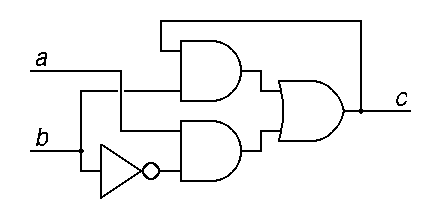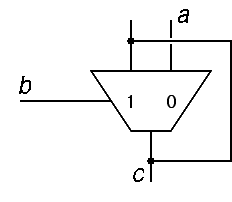LIW R1,#01234567 LIW R2,#12345678 LIW R3,#23456789 LIW R4,#3456789A LIW R5,#456789AB LIW R6,#56789ABC STUFFB R1,R2,R3 EXTB R4,R5,R6What registers are changed by the last two lines, and what are their new values? (2 points)
Register New Value __R1__ ___01237867______________ __R4__ ___000000AB______________
10 did perfectly here, while only one earned no credit at all.
About half the class substituted some value into the wrong byte of R1. About 1/3 of the class substituted the wrong byte of R2 into R1. About 1/4 of the class used some register other than R1.
About 1/3 of the class did not sign extend or zero out the high bits of R4 (either sign extension or zero were taken as correct for this exam). About 1/3 of the class did not extract the correct byte from R5.
About 1/5 of the class used 4-bits (one hex digit) as a byte.
; R3 (x), R4 (y) and R8 (z) are 2's complement fixed point numbers ; All have 24-bit integer parts 8-bit fractional parts LOAD R1,PMUL JSRS R1,R1 ; R3 = x * y _SR_____R3,8______ _ADD____R3,R3,R8__ ; R3 = x * y + z
a) Fill in the code it takes to put x * y + z in R3. There are two possibly answers; for full credit, give the answer that minimizes the likelihood of overflow in the result. (1 point)
1/4 of the class got full credit for part one of this question, and a few more had answers that were good, except that they had the alternative answer that retained a 16-bit fraction and had a higher chance of overflow during the final addition as a result. 1/8 of the class earned no creditx.
1/3 of the class had serious problems with the shift instruction, omitting it or using the wrong shift count.
b) How many bits are in the fractional part of R3 after your code? (1 point) _8_______
1/3 of the class got this right, in the context of their answer to part A, while 1/4 of the class had it entirely wrong. Partial credit was rare.

|

|
1/4 gave this answer, while about 1/4 earned no credit. Another 1/4 connected the feedback path from c back to the zero input of the MUX instead of the one input, and 1/4 labeled the one input as a. 1/6 left out the feedback path entirely, and 1/8 gave the control input some label other than b.
b) The above circuit is a kind of flipflop. What are the conventional letters used to label the inputs and outputs? (1 point)
a is __D_________
b is __C_________
c is __Q_________
Only 1 did this exactly. Only 1/8 earned no credit. Most understood the Q output, and a fair number used the names C and D for the inputs, but most of these exchanged these two.
; fileX.a ; fileY.a
INT A USE "hawk.macs"
A = 5 EXT A
END PA: W A
S .
LIW R3,A ; ???
LIL R4,A ; ???
LIS R5,A ; ???
LOAD R6,PA ; ???
END
a) Which of the above is always safe to use?
_LOAD_R6_
(0.5 points)
b) Which of the above might work, if the assembler is just a bit clever?
_LIS_R5__
(0.5 points)
c) Which of the above unlikely to work, ever?
_LIW_R3__
(0.5 points)
d) Which of the above might work, with big changes to the assembler.
_LIL_R4__
(0.5 points)
1/8 did well here, and only one earned no credit. 2/3 got part a) correct, and only a few offered other answers.
Part b) was harder (in fact, LIS R5,A can be made to assemble with only a small change to the hawk.macs file). Only 3 got this, while 1/4 got partial credit for suggesting that LIL R4 would be easy. The most popular answer, LIW was given by half the class. Here is the macro that will work just fine:
MACRO LIS r,c
B c
B #D0 | (r-R0)
ENDMACPart c) was also hard, with 3 giving the right answer. 1/8 got partial credit for LIL R4, since this would indeed be difficult to make work. The most popular answer was the easy to fix LIS.
Part d) was easier, 1/3 gave the right answer, and another 1/8 got partial credit for LIS R5. The most popular answer, given by about 1/4, was LIW.
PKBD: W #FF100000 ; address of keyboard interface
KBDDATA = 0 ; offset of keyboard data register
KBDSTAT = 4 ; offset of keyboard status register
KSTATRD = 0 ; ready
KSTATER = 6 ; error
KSTATIE = 7 ; interrupt enable
KBDGET: ; link through R1
; returns R3 = keyboard
; uses R4,R5
LOAD R5,PKBD ; R5 = pointer to keyboard interface
KPDPOLL: ; do {
LOAD R4,R5,KBDSTAT ; R4 = kbdstat
BITTST R4,KSTATRD
BCR KBDPOLL ; } while ((kbdstat & kstatrd) == 0);
; ???
LOAD R3,R5,KBDDATA
_BITTST_R4,KSTATER_______
_BCS____KBDERR___________
JUMPS R1 ; return kbddata;
KBDERR: ; else
LIS R3,#1A
JUMPS R1 ; return ASCII SUB character;
a) Add the necessary code in the space provided above. (1 point)
1/4 did well here, 1/8 earned no credit. About 1/3 used the wrong registers and a similar number used the wrong conditional branch. (Copying the pattern used to test the KSTATRD bit was too obvious?)
b) Why would it be wrong to test for error and jump to KBDERR from the point marked with "???" above? Hint: the figure below, borrowed from Chapter 11, may help. (1 point)
___The KSTATER bit is only reset by reading KBDDATA, so if the test________ ___were moved to the marked point, the KSTATER bit would never be reset,___ ___and no reads, ever again, would get the data.___________________________
4 did well here, 2 had answers that were almost good, and 1/5 more had answers that were worth at least some partial credit.

|